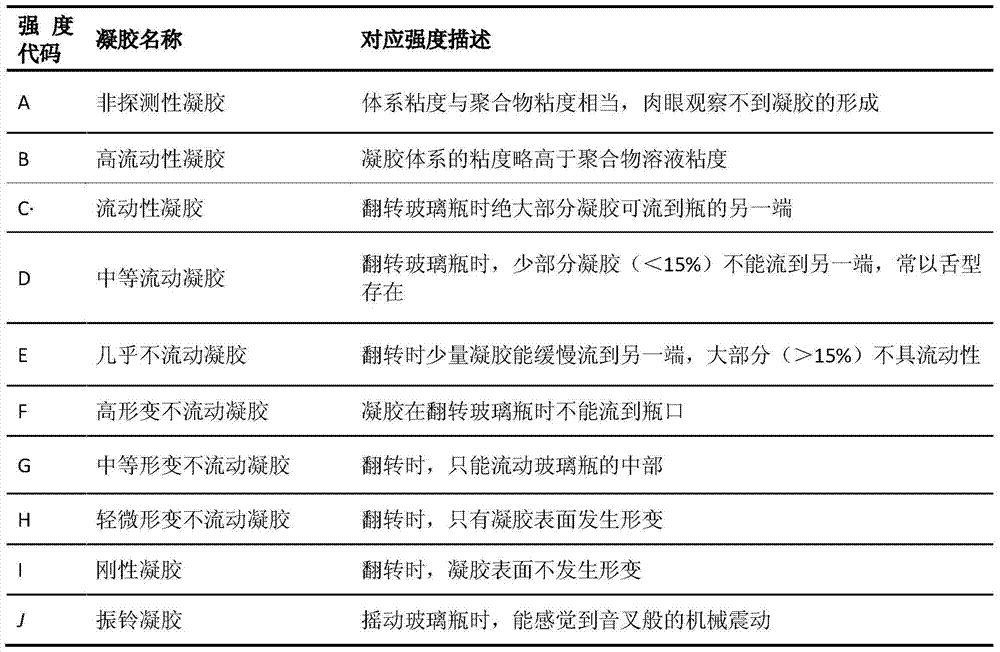A temperature-resistant, salt-resistant, high-temperature self-crosslinking in-situ polymerization water blocking gel
A temperature-resistant, salt-resistant, hydrogel technology, applied in the direction of drilling compositions, chemical instruments and methods, can solve the problems of poor thermal salt stability, less profitable on-site operation, etc., and achieve low initial viscosity and pumpability Good, high gel strength effect
- Summary
- Abstract
- Description
- Claims
- Application Information
AI Technical Summary
Problems solved by technology
Method used
Image
Examples
Embodiment 1
[0037] The total mass concentration of monomer A (acrylamide) and monomer B (hydroxyethyl methacrylate + hydroxypropyl methacrylate, the mass ratio is 1:1) is 6%, and the mass ratio of A and B is 4: 1. The concentration of crosslinking agent (formaldehyde) is 1.5%, the concentration of initiator (ammonium persulfate) varies from 0 to 0.6%, and the rest is 20×10 4 mg / L NaCl brine. The gel formation is shown in Table 2. The gel formation time is between 4 and 23 hours, the final setting strength is Class I, and no syneresis occurs in 90 days.
[0038] Table 2 Gelation of the hydrogel in Example 1
[0039]
Embodiment 2
[0041] The total mass concentration of monomer A (acrylamide) and monomer B (hydroxyethyl methacrylate + hydroxypropyl methacrylate, mass ratio is 1:1) is 4%, and the mass ratio of A and B is 3: 1. The concentration of crosslinking agent (phenolic resin) is 1%, the concentration of initiator (ammonium persulfate) varies from 0 to 0.6%, and the rest is 20×10 4 mg / L NaCl brine. The gel formation is shown in Table 3. The gel formation time is between 23 and 28 hours, the final setting strength is Class I, and no syneresis occurs in 90 days.
[0042] Table 3 Gelling situation of Example 2 of plugging hydrogel
[0043]
Embodiment 3
[0045] The total mass concentration of monomer A (acrylamide) and monomer B (isooctyl methacrylate + hydroxypropyl methacrylate, the mass ratio is 1:5) is 6%, and the mass ratio of A and B is 4: 1. The concentration of crosslinking agent (formaldehyde) is 1.5%, the concentration of initiator (2,2'-azobis(2-methylpropionamidine) dihydrochloride) varies from 0 to 0.6%, and the rest is 20× 10 4 mg / L NaCl brine. The gel formation is shown in Table 4. The gel formation time is between 5 and 23 hours, the final setting strength is Class I, and no syneresis occurs in 90 days.
[0046] Table 4 Gelation of the hydrogel in Example 3
[0047]
PUM
 Login to View More
Login to View More Abstract
Description
Claims
Application Information
 Login to View More
Login to View More - R&D
- Intellectual Property
- Life Sciences
- Materials
- Tech Scout
- Unparalleled Data Quality
- Higher Quality Content
- 60% Fewer Hallucinations
Browse by: Latest US Patents, China's latest patents, Technical Efficacy Thesaurus, Application Domain, Technology Topic, Popular Technical Reports.
© 2025 PatSnap. All rights reserved.Legal|Privacy policy|Modern Slavery Act Transparency Statement|Sitemap|About US| Contact US: help@patsnap.com



